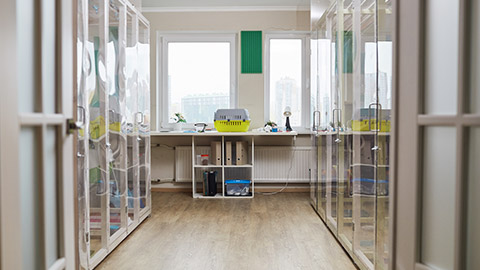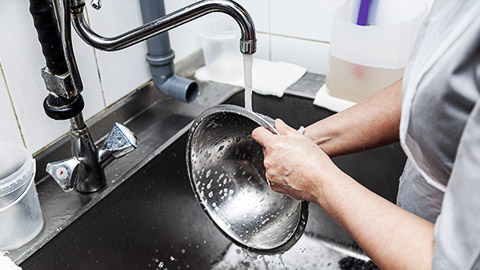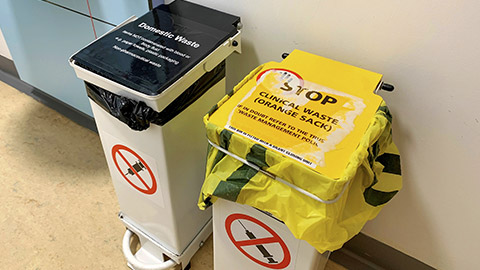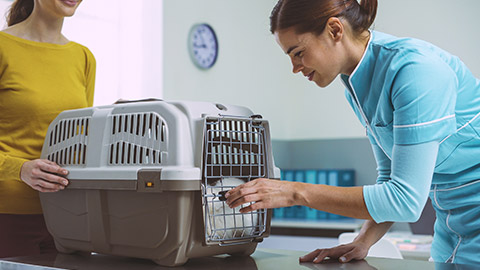Once you have completed the required activity with the animal and returned it to its enclosure or owner, you then need to clean up. This involves cleaning items and surfaces and sanitising or disinfecting, as required, then putting everything away. The last clean up task you should complete is to follow the most appropriate hand hygiene for the situation.
Sanitation routines

It is important to clean and tidy up after each animal interaction to ensure all:
- equipment is clean, in good working order and located where all staff know they can access it
- surfaces are clean and hygienic
- products are available and located where all staff know they can access them
- wastes are disposed of correctly and safely.
The specific sanitation routine you need to follow will depend on your workplace and the animal activity that was completed. For example, cleaning up after a medical procedure in a veterinary clinic will be a very different process from cleaning up after a dog training session in the park.
Cleaning versus sanitising and disinfecting
It is important to note that cleaning, sanitising and disinfecting, are three different processes.
- Cleaning is a physical process that removes visible dirt, grime and other types of soiling with the physical action of scrubbing or wiping. Cleaning may involve products, such as detergents, which are designed to break up substances, such as grease and oils, to help remove them from surfaces.
- Sanitising is a chemical process that kills many types of bacteria on surfaces.
- Disinfecting is a chemical process that kills bacteria, fungi and inactivates viruses on surfaces. The chemicals required for disinfecting are much stronger than those for sanitising (Diversey Australia 2020).
Anytime there is visible or “gross soil” on a surface, staff must first clean before disinfecting or sanitising.Diversey Australia, 2020
Cleaning and hygiene products
There is a vast array of cleaning, sanitising and disinfecting products that are suitable for use in the animal care industry. Different sanitising and disinfecting products will target different types of bacteria, fungi and viruses. You must read the manufacturer’s instructions for use and follow your workplace procedures when selecting the correct product for the job.
Many sanitising and disinfecting products can be purchased in a concentrated or diluted, ready-to-use form. Check the product to confirm which type it is. If dilution is required, follow the manufacturer’s dilution ratio and the dilution instructions provided previously in Topic 3, Subtopic 3.
Cleaning products include dishwashing detergents, clothes-washing detergents and surface sprays. Remember that cleaning products do not sanitise or disinfect.
F10 Products is a brand of hygiene products that are commonly used in the animal care industry. They supply a range of disinfectants and hand washes. Some products are strictly disinfectants only, while some are both a cleanser and a disinfectant. Make sure you read the label on the product to determine its specific purpose. For example, is the product for hard surfaces only, rinsing solid fruit, cold sterilising surgical instruments or for washing your hands?
Ensure all used items and surfaces are clean and hygienic

The following is a list of general steps to take when cleaning items and surfaces after an animal interaction. The specific steps will depend on what items and equipment were used, the type of interaction and your workplace requirements. Always follow your workplace policies and procedures to ensure you meet the required standards of hygiene and sanitation.
- Check all items and equipment that were used in the animal interaction for damage. Either record the damage and send the equipment for repair or dispose of it correctly. If equipment needs to be replaced, notify the appropriate staff member to order another one.
- Some items, such as slip leads or bridles, will not require cleaning unless they are visibly soiled. Check for soiling. If the items are clean, store them in their designated place.
- As a general rule, anything that has been or is suspected of having been in an animal’s mouth, or in contact with bodily fluids or wastes or is visibly soiled must be washed. Wash all used items and surfaces with hot, soapy water. Allow to air dry or dry with a clean cloth or paper towel.
- If your workplace procedures stipulate that an item or surface must be sanitised or disinfected, use the specified product to do so.
- Wash used towels in the washing machine and line-dry or dry in a dryer.
- Once clean and hygienic items and equipment are completely dry, store them in their designated place.
- If required by your workplace, record that the items or area have been cleaned, making sure to record the full name of the product you used. For example, F10 CLXD (Veterinary Disinfectant/Cleanser) rather than just F10.
Disposing of waste correctly

There are typically three classes of waste in the animal care industry. The specific bins available will depend on the needs of your workplace. Make sure you follow your workplace policies and procedures for disposing of waste in the correct place.
- General waste items include non-infectious, non-harmful items such as product packaging, disposable PPE, food scraps and healthy animal waste (faeces). General waste bins may include landfill, recycling and compost bins.
- Biohazard waste includes anything that has come in contact with an animal that is known to have or is suspected of having an infectious disease. Biohazard bins will be clearly labelled as such. Biohazard bins often specify whether they are ‘sharps’ bins or not. You can only place broken glass or needles into a sharps bin.
- Clinical waste or surgical waste includes anything left over from a surgical procedure, including used gauze swabs, blood and tissue. Clinical waste is collected by a licenced operator and incinerated (burnt at extreme temperatures).
Product storage and stock control
Check all the products you used during the animal interaction. If the product has been used up, dispose of the packaging appropriately. Otherwise, make sure the packaging is sealed properly and store it appropriately. Correct storage will depend on the product in question. For example, open bottles of shampoo or cleaning products may be stored on a shelf, while open containers of wet animal food should be refrigerated.
Record the usage of products in your workplace inventory. If it is appropriate for your role, check the stock levels for the products you used and reorder them, if necessary.
Hand hygiene

The last task you must complete after interacting with an animal is to wash your hands. Hand hygiene is critical in the animal care industry to prevent potential contamination or spreading of infectious disease between animals and to people.
You should wash your hands after every animal interaction, whether you will immediately work with another animal or not. Wash your hands before eating or drinking and before touching any shared equipment, such as telephones or computers.
The type of hand hygiene you should use will depend on the animal and the activity you just completed. A routine handwash will be sufficient in most situations. An antiseptic hand wash or handrub (if clean water is not available) will be necessary after exposure to blood or other bodily fluids, faeces, pathology samples or any contact with an animal that has or is suspected of having an infectious disease.
Revise the different hand hygiene routines outlined in Topic 1, Subtopic 2: Safety First.
Provide objective feedback about the animal’s behaviour

It is important to share any behavioural information about an animal with all relevant staff at your workplace. That way, everyone is aware of the animal’s current arousal level, emotional state and any known triggers. Sharing information about an animal’s behaviour doesn’t mean you can skip the distance assessment, however!
Providing verbal feedback about an animal is a quick way to share behavioural information, particularly if an animal is showing concerning or potentially dangerous behaviours. Sudden or unexpected changes in behaviour should also be reported quickly.
Inform your supervisor, manager and/or your team as appropriate to your role and your workplace policies and procedures. You can provide the information during a regular team briefing or call a meeting if you believe the behavioural information to be urgent. For example, if you decide to stop your approach of an animal due to its over-threshold arousal level and negative emotional state, it may be important to let all other staff know not to approach the animal for at least 20 minutes. In these instances, you may also need to post signage on the enclosure to warn other staff not to approach the animal, or to handle it in a particular way.
When sharing behavioural information about an animal, make sure to use appropriate industry terminology, so everyone has a shared understanding, and try not to anthropomorphise.
Update file notes and post signage if needed.
Update records

Recording behaviour
Not all relevant staff members will be available at every briefing or meeting. Recording behavioural information is another way to share the information with the appropriate people.
Update the animal’s file notes with behavioural information. Follow your workplace policies and procedures as to how often you need to update animal records. For example, dogs in a rescue facility may require a brief behavioural assessment every day, while working horses on a cattle station may only need behaviour that is unusual for that individual recorded.
You will also need to meet the expectations of your workplace for the level of detail required. For example, “BAR” may be all that is required of a daily behavioural assessment, while a more detailed description and examples of specific behaviours may be required for reporting unusual or concerning behaviours.
As with providing verbal feedback, record your notes about an animal’s behaviour using objective language (not influenced by personal opinions or anthropomorphising) and appropriate industry terminology.
Depending on your workplace, animal records that require behavioural observation notes may include:
- Patient histories
- Client files
- Individual animal records
- Cage cards.
Recording other information
Make sure you record all other relevant information about the interaction you had with the animal. Other types of information you may need to record include, but are not limited to, the following:
- the time you:
- exercised the animal
- fed the animal, the quantity and product/s you fed it with
- administered a preventative health treatment and the product/s you used
- the type of groom provided
- medical procedures administered
- type of training undertaken or progress made on a training program.
Complete the following five (5) activities to check your knowledge and understanding of the key concepts of this topic. You may repeat this activity as often as you like. Use the arrows to move between the different activities.
Well done! You have now completed the theory for this module. You should now have the skills and knowledge required to identify common animal behaviours and interact safely with common companion animals.
The key concepts from this module include how to:
- assess and establish a safe and secure area to interact with animals
- identify different animal species and breeds
- recognise common animal behaviours and interpret the likely arousal level, emotional state and motivations for the behaviour
- select and apply appropriate handling techniques for an animal based on its species, breed, behaviour and individual needs
- prepare and load an animal for transport
- complete appropriate hygiene and sanitation routines after an animal interaction
- provide feedback about and update animal records with behavioural information.
Now that you have completed the theory, you can start to prepare yourself for the Structured Workplace Learning and Assessment for this block.
- Consider the type of workplace where you would like to undertake your work placement.
- Start contacting potential host organisations and potential supervisors.
The following links may be useful to extend your knowledge or support your interest in identifying and interpreting animal behaviour.
- Temple Grandin: Understanding Animal Behavior From The Animal's Perspective. A video (24:57 min) of a lecture about a different way to consider and interpret animal behaviour given by Dr Temple Grandin.
- The Animal Behaviour Centre Blog: An array of interesting blog articles on various species, behaviour and training.
